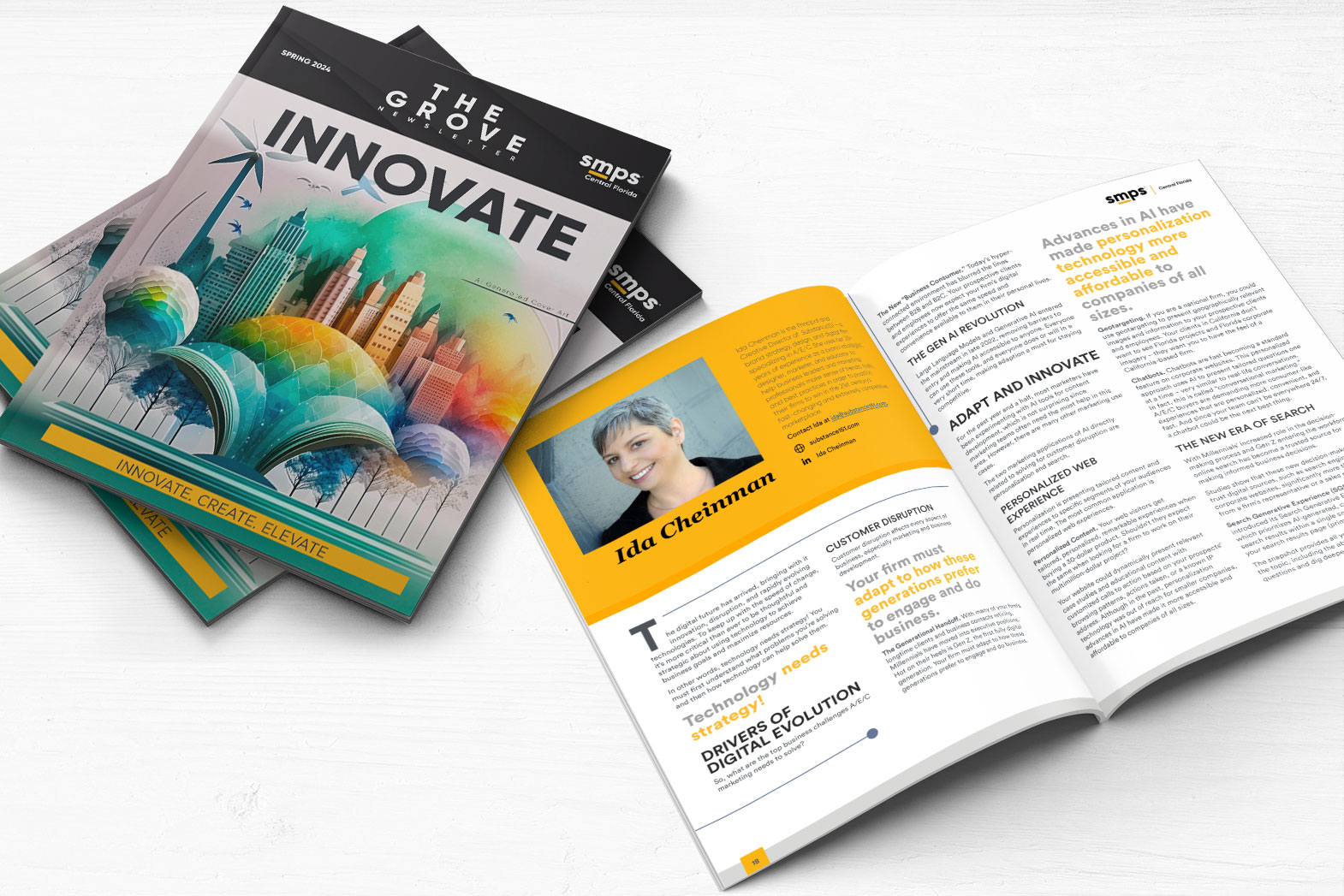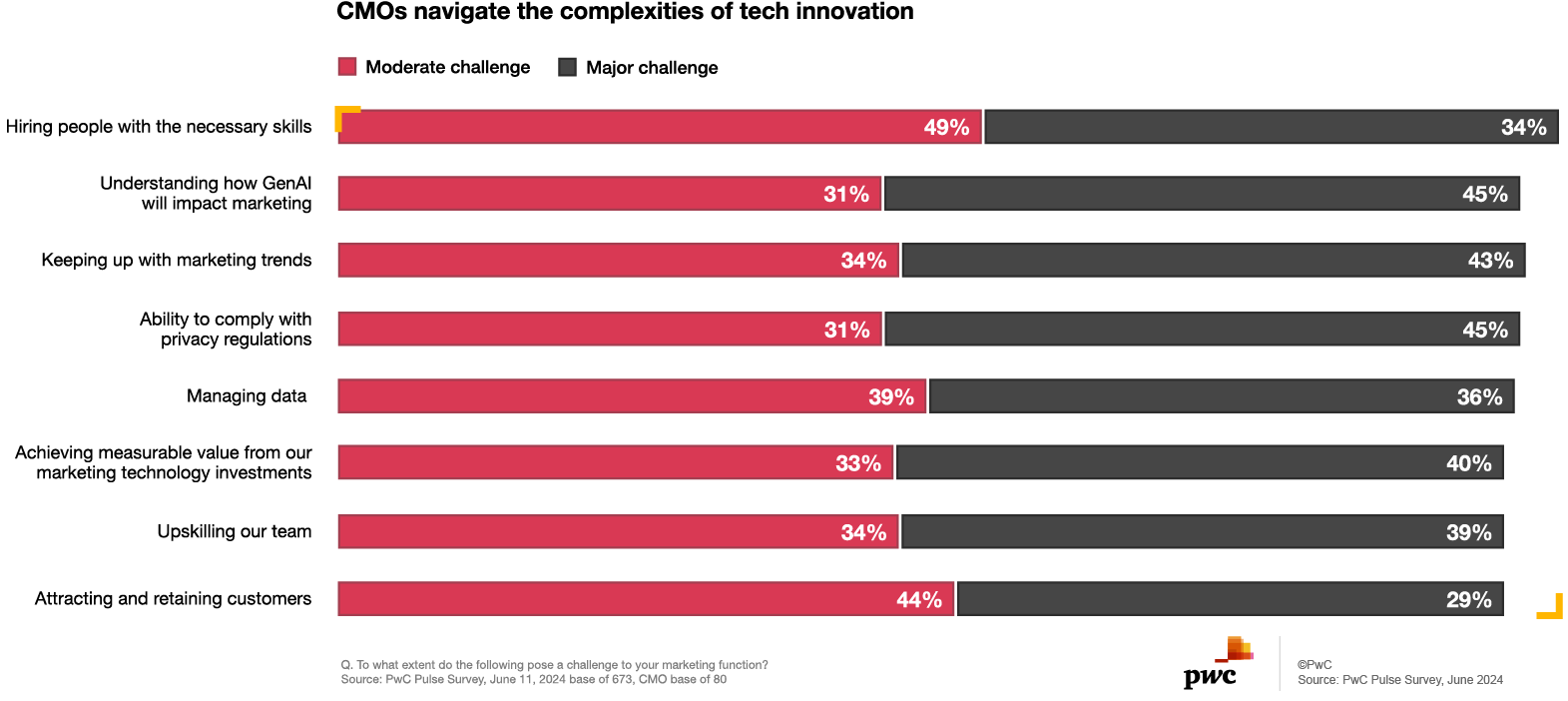This article first appeared in The Grove, an SMPS Central Florida newsletter.

The digital future has arrived, bringing with it innovation, disruption, and rapidly evolving technologies. To keep up with the speed of change, it’s more critical than ever to be thoughtful and strategic about using technology to achieve business goals and maximize resources.
Technology needs strategy! You must first understand what problems you’re solving and then how technology can help solve them.
Drivers of Digital Evolution
So, what are the top business challenges A/E/C marketing needs to solve?
Customer Disruption
Customer disruption affects every aspect of business, especially marketing and business development.

- The Generational Handoff. With many of your firm’s longtime clients and business contacts retiring, Millennials have moved into executive positions. Hot on their heels is Gen Z, the first fully digital generation. Your firm must adapt to how these generations prefer to engage and do business.
- The New “Business Consumer.” Today’s hyper-connected environment has blurred the lines between B2B and B2C. Your prospective clients and employees now expect your firm’s digital experiences to offer the same speed and convenience available to them in their personal lives.
The Gen AI Revolution
Large Language Models and Generative AI entered the mainstream in late 2022, removing barriers to entry and making AI accessible to anyone. Everyone can use these tools, and everyone does or will in a very short time, making adaption a must for staying competitive.
Also read: Today’s Digital Reality: An Essential Guide for Professional Services Marketing
Adapt and Innovate
For the past year and a half, most marketers have been experimenting with AI tools for content development, which is not surprising since marketing teams often need the most help in this area. However, there are many other marketing use cases.
The two marketing applications of AI directly related to solving for customer disruption are personalization and search.
Personalized Web Experience
Personalization is presenting tailored content and experiences to specific segments of your audiences in real time. The most common application is personalized web experiences.

- Personalized Content. Your web visitors get tailored, personalized, remarkable experiences when buying a 30-dollar product. Shouldn’t they expect the same when looking for a firm to work on their multimillion-dollar project? Your website could dynamically present relevant case studies and educational content with customized calls to action based on your prospects’ browsing patterns, actions taken, or a known IP address. Although in the past, personalization technology was out of reach for smaller companies, advances in AI have made it more accessible and affordable to companies of all sizes.
- Geotargeting. If you are a national firm, you could use geotargeting to present geographically relevant images and information to your prospective clients and employees. Your clients in Washington don’t want to see Florida projects and Florida corporate imagery – they want you to have the feel of a Washington-based firm.
- Chatbots. Chatbots are fast becoming a standard feature on corporate websites. This personalized approach uses AI to present tailored questions one at a time – very similar to real-life conversations. In fact, this is called “conversational marketing.” A/E/C buyers are demanding more consumer-like experiences that are personalized, convenient, and fast. And since your team can’t be everywhere 24/7, a chatbot could be the next best thing.
Also read: Are You Building the Right Website?
The New Era of Search
With Millennials’ increased role in the decision-making process and GenZ entering the workforce, online search has become a trusted source for making informed business decisions.
Studies show that these new decision-makers trust digital sources, such as search engines and corporate websites, significantly more than advice from a firm’s representative or a sales professional.
- Google’s AI Overviews (formerly Search Generative Experience – SGE). Google has introduced its AI Overviews, which prioritize AI-generated, contextually relevant search results within a single snapshot at the top of your search results page (prime real estate). The snapshot provides all you need to know about the topic, including the ability to ask follow-up questions and dig deeper without leaving the interface. In other words, people no longer need to click on organic links below the snapshot to get information. This could have a huge impact on your organic traffic.
- AI Interface Is the Next Google. The second significant implication of AI for search is that people are bypassing Google and other search engines and getting their answers directly from AI interfaces.
So, what does your firm’s digital presence look like to AI? Ask ChatGPT and other AI what they know about your firm. Is the information accurate? Do they know anything at all? If AI doesn’t know you, it can’t provide information when someone is looking for you.
Your brand has to be visible in the digital world. Generative AI models learn from massive sets of raw data. So, your brand-building has to focus on creating large amounts of data about your firm. However, the end goal is building credibility and trust with your human audiences, so it still has to be high-quality content. You just need a lot of it.
What’s Next?

Marketing for the future will require new knowledge, tools, and skillsets. Most importantly, it will require a new mindset. To differentiate your firm, you must look beyond the familiar (what we’ve always done), beyond what others in the industry are doing (best practices), and beyond traditional A/E/C marketing.
As marketers, we need to keep innovating and evolving – our approaches, our firms, and, together, our industries.
Let Us Help
You don’t have to venture into the new, brave digital world alone! Substance151 can be your guide – contact us to schedule a conversation.
Actionable ideas delivered straight to your inbox
Subscribe